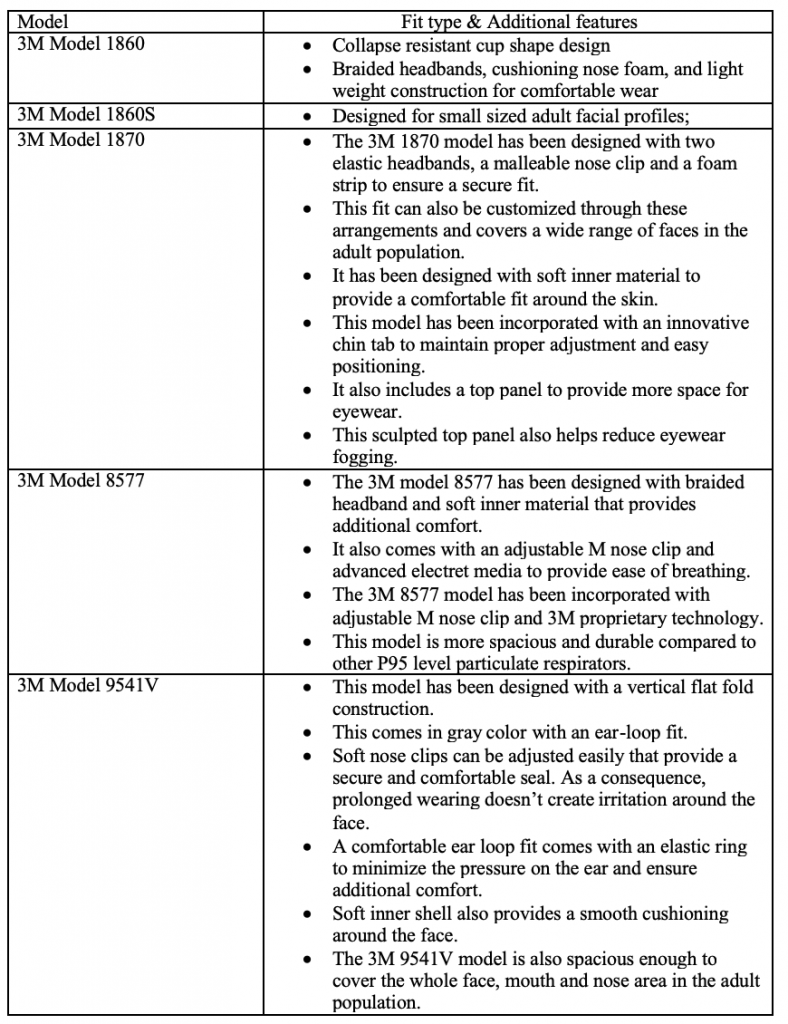N95 respirators provide effective respiratory protection against small particle aerosols (non-oil) and large droplets. N95 particulate respirators can separate at least 95% of airborne particles including both small and large particles. FDA-regulated surgical masks are fluid resistant and can provide protection against large droplets, splash and spatter of blood and other hazardous body fluids. It helps protect the patient by reducing the exposure from wearer’s respiratory emissions.
Comparison of masks in terms of fit performance
Fitting and seal around the face:
N95 respirators are designed to provide tight fitting around the face. In general, the N95 particulate respirator is intended to provide a secure facial fit and high filtration efficiency against the biological particles. The edges of the N95 particulate respirator is designed to provide a secure seal around the nose and face. Secure seal between the face and the N95 respirator ensures that most of the inhaled air passes through the filter media and consequently, most biological particles can be filtered out.

Flat surgical masks provide a loose fitting in comparison with N95 respirators. In most cases, the front curvature of surgical masks can be adjusted to fit the face better. Most surgical masks incorporate an adjustable nose bridge to fit the face shape and provide a better seal around the nose. However, it doesn’t create a secure seal around the face and often leaves gaps between the face and the mask. As a result, most of the air cannot be drawn through the filter media of surgical mask. Cup or cone shaped surgical masks are expected to provide a tighter fitting compared with flat shaped surgical mask. However, surgical mask doesn’t create a secure seal that can be relied upon to provide an effective respiratory protection.
Fitting and comfort:
The combination of nose strip, soft inner material ensures a comfortable fit that is convenient for prolonged use. Most N95 respirators are designed to fit a wide range of face shapes and sizes. N95 masks often use a two head-strap method to secure the mask to the wearer’s face: one strap goes around the back of the head under the ears, while the other strap goes on the top over the crown of the head above the ears.
Surgical masks are lightweight, soft, and easy to put on or remove. Surgical masks are designed with an elastic ear-loop to ensure a comfortable fit to the ears.
Fit test:
According to OSHA guidelines, healthcare professionals are required to go through the fit test each time they use an N95 respirator. User seal check must be conducted prior to use of the respirator in any hazardous or contaminated area. Fit test are conducted in two phases: (1) qualitative fit test and (2) quantitative fit test. In case of qualitative fit test, any odor or irritation is considered as an indicator of improper fitting arrangement. Then, a direct reading instrument is used in quantitative fit test that measures the amount of particles inside and outside of the respirator to evaluate the quantitative fit index of the respirator.
Surgical masks doesn’t need to be fit tested as per OSHA guidelines.
Comparison of fit between different particulate respirators (additional features in various N95 respirators):

Comparison with cloth masks:
Cloth masks are non-FDA-regulated masks which can be used as alternatives in case of a shortage in FDA-approved masks. Cloth masks may provide a certain amount of protection against respiratory emissions. However, cloth masks have not been proven to provide effective protection for healthcare professionals or patients.
Limitations or disadvantages:
Cloth masks are not designed to protect the wearer. These masks should not be used by the people who are sick. Breathing into a cloth mask builds up moisture inside the mask that makes it uncomfortable to wear. Cloth masks also need to be cleaned and sanitized on a regular basis.

